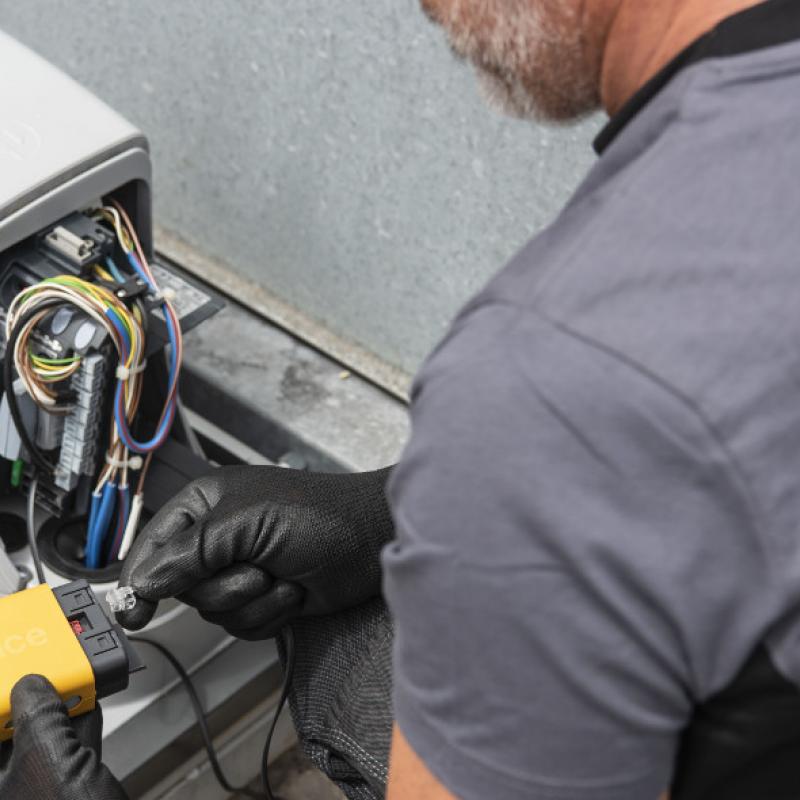Videos and FAQ
M-Bar and L-Bar
Solution
FAQ
1) What can I do if, when I press any transmitter key, the corresponding LED does not come on and the barrier does not move?
Check whether the transmitter batteries are flat and replace with a new pair if necessary.
2) What can I do if the barrier does not receive the commands from the transmitter?
Make sure the transmitter has been correctly associated with the receiver installed in the control unit of the barrier. If this is not the case, try repeating the memorisation procedure as shown in the video.
3) How should I interpret the behaviour of the flashing light on the barrier when I send a command but the barrier does not perform any manoeuvre?
If when you send a command to the barrier, the barrier does not perform the manoeuvre and the flashing light remains off, make sure the command has actually been received: if the command reaches the PP input of the control unit correctly, the OK LED will flash twice.
If the flashing light comes on, observe the number of short flashes. These are repeated twice, separated by a one second pause.
| Number of flashes | Diagnostics | Possible action |
| 1 | BlueBUS error | The BlueBUS devices recognised do not correspond to those memorised during the self-learning phase. Check whether the devices in question are malfunctioning and if so, replace them. If you make any changes, the device self-learning procedure must be repeated. |
| 2 | Photocell activated | At the beginning of the manoeuvre, one or more photocells have not enabled the movement. Check to see if there are any obstacles. |
| 3 | "Motor force" limiter triggered | During the movement, the pole has encountered greater force. Check the cause. |
| 4 | STOP input triggered | Check the connections on the STOP terminal to identify the cause leading to triggering of the input at the beginning of, or during, the manoeuvre. |
| 5 | Error in the internal parameters of the control unit | Turn power to the barrier off then on again. If the error persists, totally delete the control unit memory, then install and programme the control unit again. If the error state persists even after this procedure, check the electronic board and replace if faulty. |
| 7 | Electrical circuit error | Disconnect all power circuits for a few seconds, then try sending a command again. If the error state persists, check the electronic board and motor connections and replace if faulty. |
| 9 | Automation block | Send the "release automation" command, or command the manoeuvre through the transmitter with the "High Priority Step Step" function. |
4) During a manoeuvre, why does the barrier block almost immediately or briefly invert movement?
An excessively low force value may have been set. Check that the pole is correctly balanced, following the procedure shown in the video, and if necessary try setting a higher force value.
If the pole is correctly balanced, the block or inversion of movement could be caused by an excessively high sensitivity value: in this case, try setting a lower value.
If the pole movement blocks or movement is briefly inverted during the deceleration phase, reduce the braking intensity.
5) Why does the barrier perform the manoeuvre slowly?
There could be two reasons: either the manoeuvre does not start from one of the limit switches or the control unit does not recognise them. Check the electrical connection of the limit switches.
6) What should I do if the barrier which should operate as the Secondary does not perform the manoeuvres?
The Primary/Secondary function is used to automate two opposed barriers to synchronise their movements.
When this mode is set, one barrier operates as the Primary and commands the manoeuvres, while the second operates as the Secondary and performs the commands sent by the Primary barrier.
By default, all barriers are set as Primary barriers, you should therefore check that the Primary/Secondary self-learning phase has been performed on both barriers.
7) Why does the barrier perform the opposite manoeuvre?
The "direction of motor rotation" parameter may not have been set correctly. To invert the direction of motor rotation:
- press and hold the STOP key of the control unit until LED L1 starts flashing;
- press the CLOSE key repeatedly until LED L8 starts flashing;
- press the STOP key once.
After performing this procedure, position the pole at 45° and perform the position search procedure. For the complete procedure, see the video relative to programming M and L Bar road barriers.
Alternatively, the direction of motor rotation can be modified by inverting the cables.

